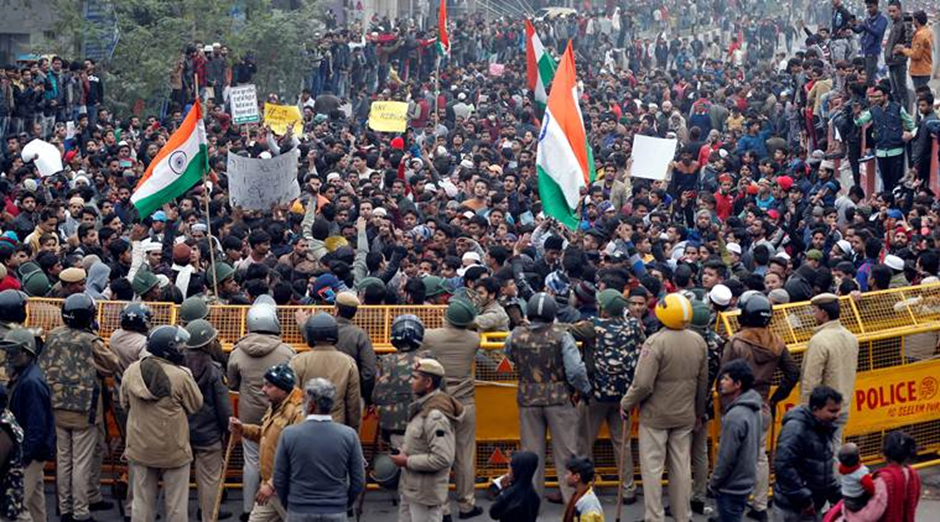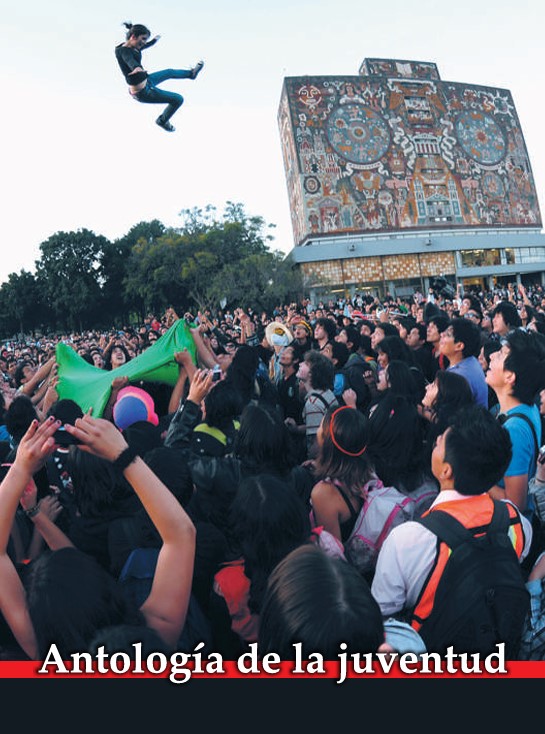Estudiantes indios rechazan política de odio
Sagar Hugar
Estudiante de Nuevos Medios y Cultura Digital, Universidad de Amsterdam.
En los últimos días, India ha sido testigo de severas protestas, derramamiento de sangre y acalorados debates. Hasta ahora se han reportado alrededor de 11 muertes en las protestas, las muertes no reportadas y el número de manifestantes que luchan contra la vida en los hospitales es grande y desconocido. En el centro de esta controversia y en el extremo receptor de toda la ira está el actual gobierno nacionalista hindú de derecha dirigido por el primer ministro Narendra Modi (del partido político BJP). Ahora, averigüemos cuál es el problema y por qué están ocurriendo las protestas.
El 11 de diciembre, el parlamento de la India aprobó la Ley de Enmienda de Ciudadanía (CAA por sus siglas en inglés, Citizenship Amendment Act). En virtud de esta ley, los inmigrantes que habían ingresado a la India desde países vecinos de Afganistán, Bangladesh y Pakistán por temor a la persecución religiosa en su país de origen fueron elegibles para la ciudadanía. El problema aquí es que las personas que podrían probarse a sí mismas como hindúes, cristianos, parsis, jainistas o budistas serán aceleradas para obtener la ciudadanía, mientras que el acto excluye descaradamente a los musulmanes.
Entonces, ¿por qué excluir a los musulmanes es un problema?
Los ciudadanos indios y otros intelectuales públicos argumentan que la nueva enmienda a la ley es inconstitucional y no respeta los valores seculares de la India. India y su vecino Pakistán eran un solo país hace unas décadas. Después de 200 años de gobierno británico, India y Pakistán obtuvieron la independencia en el año 1947. Mientras que los líderes fundadores de Pakistán querían que su nación fuera una República Islámica, los líderes fundadores indios querían que la nación no tuviera una religión oficial y, por lo tanto, India independiente era una nación secular que daba la bienvenida a personas de todas las religiones y estilos de vida. Si bien es cierto que más del 80% de la población india es hindú, los hindúes solo son reconocidos como la religión más grande por población, pero no la oficial. India también es el hogar de la tercera población musulmana más grande del mundo, a pesar de que constituyen aproximadamente un 14% de la población total del país. Entonces, la pregunta que se plantea es: ¿por qué el gobierno actual está dando ciudadanía a todas las demás religiones principales, excepto a los musulmanes? El argumento que se hace; La ley es discriminatoria, inconstitucional y se opone al ethos secular de la India.

También hay una segunda razón por la cual la gente protesta; Los ciudadanos del estado de Assam, en el noreste de India, que comparten una frontera con Bangladesh, siempre han sido identificados por sus culturas distintivas y durante mucho tiempo se sospechó que los migrantes del país vecino diluyen sus culturas únicas. A diferencia de la mayoría del país, los asameses no están necesariamente enojados con la naturaleza religiosamente discriminatoria de la ley, sino quehan estado exigiendo que se revoque toda la ley ya que CAA podría alentar a más y más personas de Bangladesh a ingresar a Assam, dañando posteriormente su indigenidad.Cabe señalar que las primeras protestas contra CAA se iniciaron en Assam.
Para empeorar las cosas, el primer ministro Narendra Modi también quiere presentar el Registro Nacional de Ciudadanos (NRC) en todo el país. NRC requiere que todos los residentes actuales de la India demuestren su ciudadanía con base en cierto conjunto específico de documentos como certificados de nacimiento y certificados de linaje. Ha habido una preocupación generalizada de que no muchos (independientemente de su religión) puedan proporcionar los documentos requeridos para la NRC por varias razones. Si no puede presentar los documentos, la persona será retenida como inmigrante ilegal. Ahora, si se considera a CAA junto con NRC, una persona no musulmana que no ha demostrado su ciudadanía todavía es elegible para una ciudadanía a través de CAA si demuestra que su religión es hindú, cristiana, parsi, jainista, o budista. Pero si una persona musulmana no prueba su ciudadanía, no hay otra manera de demostrar que es ciudadano, ya que CAA declara abiertamente que no permitirá que una persona ilegal / migrante que sea musulmana solicite la ciudadanía. De esta manera, CAA y NRC no solo discriminan a los musulmanes migrantes, sino que también discriminan a los ciudadanos musulmanes legales de la India.
Muchos intelectuales públicos dentro y fuera de India especulan que estos desarrollos son un caso claro de “limpieza étnica” por parte del gobierno actual. La supuesta razón es la ideología hindú-nacionalista del gobierno actual que siempre ha estado en una guerra comunal con los musulmanes. Los manifestantes también han establecido paralelismos entre el odio de Adolf Hitler por los judíos con los desarrollos actuales en la India.
Entonces, ¿qué está pasando ahora?
El 15 de diciembre, estudiantes de la Universidad Jamia de Delhi organizaron una gran manifestación de protesta contra el primer ministro Narendra Modi. Como represalia, se alega que Modi usó los poderes del estado para frenar la disidencia cuando se vio a la Policía de Delhi irrumpir en el campus universitario de Jamia sin previo aviso y agredir físicamente a estudiantes y académicos. Este incidente provocó una gran ira entre los estudiantes y la comunidad académica de la India, en los próximos 3 días, estudiantes de más de 50 instituciones educativas expresaron su disidencia contra CAA y NRC y también contra el uso indebido flagrante del poder por el Primer Ministro Modi para frenar la disidencia en una democracia. Estas protestas pronto se convirtieron en protestas estudiantiles para disentir en todo el país por personas de todos los ámbitos de la vida que se oponen a las intenciones de CAA y NRC.
Lo más destacado de la protesta es que las mujeres en general y las estudiantes en particular han sido las líderes en la protesta. Las estudiantes en la imagen de abajo son celebradas como la cara de este movimiento, ya que fueron vistas resistiéndose a la policía mientras una contraparte masculina estaba siendo golpeada por la policía.
El primer ministro Modi cortó Internet y aplicó la prohibición general de la comunicación en algunos lugares para frenar las protestas. También se dieron órdenes de precaución para no organizar protestas. Pero eso no ha disuadido a los manifestantes enojados de salir. A partir de ahora, ha habido 25 muertes durante las protestas debido a los enfrentamientos entre la policía y los manifestantes. En medio de todas las acusaciones de ser la razón detrás de la erosión de los valores democráticos y seculares de la India y la razón detrás de los disturbios actuales de la India, el primer ministro Modi no ha comentado mucho sobre los acontecimientos y las protestas aún continúan.
Indian students push back PM Modi’s politics of hate
In the last few days, India has been a witness to severe protests, bloodshed and heated debates. Around 11deaths have been reported so far in the protests, the unreported deaths and the number of protestors who are battling life in hospitals is large and unknown. At the very centre of this controversy and at the receiving end of all the anger is the current right-wing Hindu nationalist government lead by Prime Minister Narendra Modi (of the political party BJP). So, let’s find out what the issue is and why are the protests happening.
The parliament of India on December 11th passed Citizenship Amendment Act (CAA). Under this act, migrants who had entered India from neighbouring countries of Afghanistan, Bangladesh and Pakistanbecause of the fear of religious persecution in their origin country were being made eligible for citizenship. The catch here is, people who could prove themselves as Hindus, Christians, Parsis, Jains or Buddhists will be fast-tracked for citizenships, while the act blatantly excludes Muslims.
So, why is excluding Muslims an issue?
Indian citizens and other public intellectuals argue that the new amendment to the act is unconstitutional and disrespects India’s secular values. India and its neighbour Pakistan were one single country a few decades ago. After 200 years of ruling by the British, India and Pakistan got independence in the year 1947. While the founding leaders of Pakistan wanted their nation to be an Islamic Republic, Indian founding leaders wanted the nation to not have an official religion and hence independent India was a secular nation that welcomed people from all religions and walks of life. While it is true that more than 80% of the Indian population is Hindu, Hindus are only recognizedas the largest religion by population but not the official one. India is also a home for the third largest Muslim population in the world, despite them constituting just an approximate of 14% of the country’s total population. So, the question being raised, why is the current government giving citizenship to all other major religions except for Muslims? The argument beingmade; the law is discriminatory, unconstitutional and stands against the secular ethos of India.
Image: Students protesting against CAA in capital Delhi
There is also a second reason on why people are protesting; citizens of north-eastern Indian state of Assam, who share a border with Bangladesh have always been identified for their distinctive cultures and there has long been a suspicion that their unique cultures are being diluted by migrants from the neighbouring country. Unlike majority of the country, Assamese are not necessarily angered with the religiously-discriminatory nature of the law, but they have been demanding the whole law to be rolled backas CAA might encourage more and more people from Bangladesh to enter Assam, subsequently harming their indigenity. It is to be noted that the very first protests against CAA were initiated in Assam.
To make things worse, PM Narendra Modi also wants to introduce National Register of Citizens (NRC) throughout the country. NRC requires all current residents of India to prove their citizenship based on certain specific set of documentations like birth certificates and lineage certificates. There has been a widespread concern that not many (regardless of religion) would be able to provide required documents for NRC because of several reasons. If failed to produce the documents, the person will be held as an illegal migrant. Now, if CAA is looked in tandem with NRC, a non-Muslim person who has failed to prove his/her citizenship is still eligible for a citizenship through CAA if he/she proves their religion to be either Hindu, Christian, Parsi, Jain or Buddhist. But if a Muslim person fails to prove his/her citizenship, there is no other way to prove he/she is citizen as CAA blatantly states it won’t allow an illegal person/migrant who happens to be a Muslim to apply for citizenships. This way, CAA & NRC are not just discriminatory towards migrant Muslims, but also discriminate against currently legal Muslims citizens of India.
Many public intellectuals in and outside of India speculate these developments to be a clear case of ‘ethnic cleansing’ by the current government. The alleged reason being the Hindu–nationalist ideology of the current government who have always been at a communal war with the Muslims. Protestors have also drawn parallels between Adolf Hitler’s hate for Jews with the current developments in India.
So, what’s happening now?
On December 15th, students of the Jamia University from Delhi staged a huge protest-rally against PM Narendra Modi. As a retaliation, Modi is alleged of using state powers to curb dissent as the Delhi Police was seen storming into the Jamia university campus without a notice and physically assaulting students and academics. This incident sparked a huge anger among the students and academic community of India, in the next 3 days, students from more than 50 educational institutions expressed their dissent against CAA & NRC and also against the blatant misuse of power by PM Modi to curb dissent in a democracy. These protests soon snowballed from being student protests to nation-wide dissent by people from all walks of life who oppose the intents of CAA & NRC.
The highlights of the protest being, women in general and female students in specific have been the leaders in the protest. The female students in the below image are being celebrated as the face of this movement as they were seen resisting the police while a male counterpart of theirs was being beaten up by the police.
Prime Minister Modi has also cut down internet and applied blanket ban on communication in a few places to curb protests. Cautionary orders too were given out not to stage protests. But that hasn’t deterred the angry protestors from coming out. As of now, there have been 11 deaths during the protests because of clashes between the police and the protestors. Amidst all allegations of being the reason behind the erosion of India’s democratic and secular values and the reason behind India’s current unrest, PM Modi hasn’t commented on the developments much and the protests are still on.
Sagar Hugar
Student of New Media & Digital Culture, University of Amsterdam



